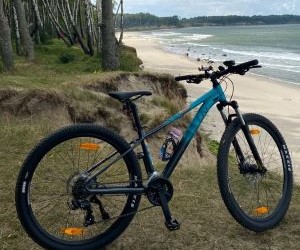Learn how to choose gravel bike geometry by comparing stability, comfort, and performance factors that match your riding style and terrain needs.
WHAT ARE THE MOST IMPORTANT CYCLING GEAR ESSENTIALS?
Cycling is more than just a bike—it’s a gear-driven lifestyle where every piece of equipment matters. Whether you're new to the sport or a seasoned rider upgrading your kit, understanding the essentials can make the difference between a smooth ride and a suffer-fest. From safety-first equipment to performance-enhancing tech, this guide breaks down what truly matters and why, so you can ride smarter, longer, and with total confidence.

Why proper gear makes a difference
Cycling is a sport of details, and your gear choices directly affect your comfort, safety, and performance. Investing in the right essentials doesn't just make your ride smoother—it makes it safer, more efficient, and more enjoyable.
Good gear is about more than style. Proper cycling equipment reduces fatigue, improves aerodynamics, regulates temperature, and provides protection. Whether you’re climbing steep hills or descending at high speeds, the right setup keeps you confident and in control.
The benefits of having key gear
Enhanced safety: Helmets, lights, and visibility gear reduce accident risk.
Improved comfort: Padded shorts, gloves, and jerseys prevent fatigue and irritation.
Performance boost: Clipless pedals, power meters, and GPS help track and improve your output.
Better ride preparedness: Essentials like multitools, tubes, and pumps keep you rolling.
Longer ride capability: Hydration systems and fuel storage extend your time on the bike.
Cyclists who neglect gear often find themselves sidelined—either by mechanicals, weather, or physical discomfort. Don’t let that be you. Gear up wisely, and you’ll ride with confidence across all terrains and conditions.
Top 10 must-have cycling essentials
From head to toe and everything in between, here are the most critical pieces of cycling gear you should never ride without. These items are the foundation of every cyclist’s setup—whether you ride road, gravel, or trail.
Essential gear checklist
Helmet: Non-negotiable. Choose one with MIPS technology and proper ventilation for safety and comfort.
Cycling shorts: Look for padded (chamois) bibs to reduce saddle sores and fatigue.
Gloves: Protects against road vibration and adds crash protection.
Jersey: Wicks moisture and holds snacks, tools, and ID in rear pockets.
Clipless pedals & shoes: Maximize pedaling efficiency and power transfer.
Flat repair kit: Include spare tube, tire levers, CO2 inflator or mini pump.
Multitool: Essential for quick on-the-go adjustments and emergency fixes.
Lights: Front and rear for visibility during dawn, dusk, or night rides.
Water bottle & cage: Stay hydrated on any ride longer than 30 minutes.
Cycling computer or GPS: Track distance, speed, route, and performance data.
These essentials create a reliable setup for most riding conditions. Depending on your discipline, you might also add knee/elbow pads, a hydration backpack, or a power meter. The key is preparation—gear that supports your ride style and goals.
Upgrades and extras worth considering
Once you’ve covered the basics, there’s a whole world of upgrades that can further optimize your ride. While not strictly “essentials,” these extras improve data tracking, comfort, performance, and enjoyment. Think of them as strategic investments in your cycling experience.
Whether you're racing or just love numbers, gear upgrades help you train smarter, ride longer, and recover better. Some add speed, others add comfort—and some just make your life easier.
Valuable cycling gear extras
Power meter: The gold standard for training. Measures actual output and helps dial in zones.
Smart trainer: Ideal for structured training in all weather and precise workout control.
Cycling sunglasses: Protects eyes from wind, UV rays, and debris.
Bike-mounted saddlebag: Stores flat kit and snacks without cluttering your jersey.
Heart rate monitor: Adds another data point for training efficiency and load monitoring.
Also consider high-visibility gear for commuting, anti-chafe creams for long rides, and weather-specific gear like thermal gloves or rain jackets. Great rides start with great prep, and the more equipped you are, the more miles you’ll enjoy.
Don’t fall for marketing fluff—invest in gear that aligns with your riding needs, not trends. Focus on function, fit, and durability. With the right gear, even bad weather or long climbs become part of the fun, not reasons to turn back.
YOU MAY ALSO BE INTERESTED






